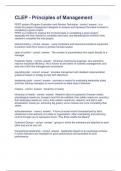Exam (elaborations)
Test Bank for Nutrition: A Functional Approach, 4th Canadian Edition by Thompson
Test Bank for Nutrition: A Functional Approach 4ce 4th Canadian Edition by Janice Thompson, Melinda Manore, Brenda Hartman. Complete Chapters test bank included Ch 1 - 15. Nutrition: Linking Food and Health Designing a Healthful Diet The Human Body: Are We Really What We Eat? Achieving and Ma...
[Show more]












